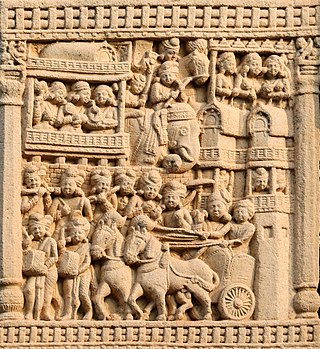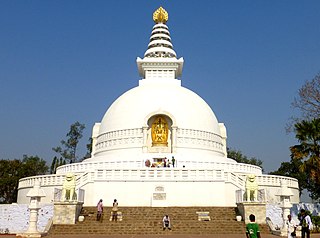Related Research Articles

Magadha also called the Kingdom of Magadha or the Magadha Empire, was a kingdom and empire, and one of the sixteen Mahajanapadas, 'Great Kingdoms' of the Second Urbanization, based in southern Bihar in the eastern Ganges Plain, in Ancient India. Magadha was ruled by the Brihadratha dynasty, the Haryanka dynasty, the Shaishunaga dynasty, the Nanda dynasty, the Mauryan dynasty, the Shunga dynasty and the Kanva dynasty. It lost much of it territories after being defeated by the Satavahanas of Deccan in 28 BC and was reduced to a small principality around Pataliputra. Under the Mauryas, Magadha became a pan-Indian empire, covering large swaths of the Indian subcontinent and Afghanistan.

Bindusara, also Amitraghāta or Amitrakhāda or Amitrochates was the second Mauryan emperor of Magadha in Ancient India. He was the son of the dynasty's founder, Chandragupta, and the father of its most famous ruler, Ashoka. Bindusara's life is not as well documented as the lives of these two emperors. Much of the information about him comes from legendary accounts written several hundred years after his death. He justified his title of ‘Enemy-Slayer’ by extending his father’s empire across the Deccan to include the Mysore region — but failed to take the powerful kingdom of Kalinga to the east. These victories would have strengthened the position of Bindusara’s Kshatriya army, threatening the supremacy of the Brahmans at court.

Bimbisāra or Shrenika and Seniya in the Jain histories was the King of Magadha and belonged to the Haryanka dynasty. He was the son of Bhattiya. His expansion of the kingdom, especially his annexation of the kingdom of Anga to the east, is considered to have laid the foundations for the later expansion of the Mauryan Empire.

Ajatasattu or Ajatashatru in Buddhist tradition, or Kunika and Kuniya in the Jain histories, was one of the most important kings of the Haryanka dynasty of Magadha in East India. He was the son of King Bimbisara and was a contemporary of both Mahavira and Gautama Buddha. He forcefully took over the kingdom of Magadha from his father and imprisoned him. He fought a war against the Vajjika League, led by the Licchavis, and conquered the republic of Vaishali. The city of Pataliputra was formed by fortification of a village by Ajatashatru.

The Shaishunaga dynasty was the fourth ruling dynasty of Magadha, an empire in ancient India. According to the Hindu Puranas, this dynasty was the second ruling dynasty of Magadha, succeeding Nagadashaka of the Haryanka dynasty.

Rajgir, meaning "The City of Kings," is a historic town in the district of Nalanda in Bihar, India. As the ancient seat and capital of the Haryanka dynasty, the Pradyota dynasty, the Brihadratha dynasty and the Mauryan Empire, as well as the dwelling ground of such historical figures as The Buddha and The Mahavira, the city holds a place of prominence in Hindu, Buddhist and Jain scriptures. As of 2011, the population of the town was reported to be 41,000 while the population in the community development block was about 88,500.

Kosala, sometimes referred as "Uttara Kosala" transl. "Northern Kosala") was one of the sixteen great realms of ancient India. It emerged as a small state during the Late Vedic period and became one of the earliest states to transition from a lineage-based society to a monarchy. By the 6th century BCE, it had consolidated into one of the four great powers of ancient northern India, along with Magadha, Vatsa, and Avanti.

The Mahājanapadas were sixteen kingdoms or oligarchic republics that existed in ancient India from the sixth to fourth centuries BCE, during the second urbanisation period.

Patna, the capital of Bihar state, India, is one of the oldest continuously inhabited places in the world and the history of Patna spans at least three millennia. Patna has the distinction of being associated with the two most ancient religions of the world, namely, Buddhism and Jainism. The ancient city of Pataliputra was the capital of the Mauryan, Shunga, and Gupta Empires.

The history of Bihar is one of the most varied in India.Chirand, on the northern bank of the Ganga River, in Saran district, has an archaeological record dating from the Neolithic age. Regions of Bihar—such as Magadha, Mithila and Anga—are mentioned in religious texts and epics of ancient India. Mithila is believed to be the centre of Indian power in the Later Vedic period. Mithila first gained prominence after the establishment of the ancient Videha Kingdom. The kings of the Videha were called Janakas. A daughter of one of the Janaks of Mithila, Sita, is mentioned as consort of Lord Rama in the Hindu epic Ramayana. The kingdom later became incorporated into the Vajjika League which had its capital in the city of Vaishali, which is also in Mithila.

Malla was an ancient Indo-Aryan tribe of north-eastern Indian subcontinent whose existence is attested during the Iron Age. The population of Malla, the Mallakas, were divided into two branches, each organised into a gaṇasaṅgha, presently referred to as the Malla Republics, which were part of the larger Vajjika League.

The Haryanka dynasty was the third ruling dynasty of Magadha, an empire of ancient India. Initially, the capital was Rajagriha. Later, it was shifted to Pataliputra, near the present-day Patna in India during the reign of Udayin. Bimbisara is considered as the main founder of the dynasty.
The Ikshvaku dynasty was founded by the legendary king Ikshvaku. Also called Solar dynasty or Sūryavaṃśa, they prayed to the Surya as their prime God and considered him as their progenitor. Along with the Lunar dynasty, Solar dynasty comprises one of the main lineages of the Kshatriya Varna in Hinduism.

Pasenadi was an Aikṣvāka ruler of Kosala. Sāvatthī was his capital. He succeeded after Sanjaya Mahākosala. He was a prominent Upāsaka of Gautama Buddha, and built many Buddhist monasteries for the Buddha.

Licchavi was an ancient Indo-Aryan tribe of north-eastern Indian subcontinent whose existence is attested from the Iron Age to the Classical Age. The population of Licchavi, the Licchavikas, were organised into a gaṇasaṅgha, presently referred to as the Licchavi Republic, which was the leading state of the larger Vajjika League.
Viḍūḍabha was a king of Kosala during the lifetime of the Buddha.
Kosala Devī was Empress consort of the Magadha Empire as the first wife of Emperor Bimbisara. She was born a princess of Kashi and was the sister of King Prasenajit. Her first name is Bhadra-śrī.

Kāsī, was an ancient kingdom of India whose existence is attested during the Iron Age. The inhabitants of the Kāśī were named the Kāsikas in Pāli and the Kāśeyas and Kāśikas in Sanskrit.

Āmrapālī, also known as "Ambapālika", "Ambapali", or "Amra" was a celebrated nagarvadhu of the republic of Vaishali in ancient India around 500 BC. Following the Buddha's teachings, she became an arahant. She is mentioned in the old Pali texts and Buddhist traditions, particularly in conjunction with the Buddha staying at her mango grove, Ambapali vana, which she later donated to his order and wherein he preached the famous Ambapalika Sutra. The legend of Amrapali originated in the Buddhist Jataka Tales some 1500 years ago.

Udayin also known as Udayabhadra was a king of Magadha in ancient India. According to the Buddhist and Jain accounts, he was the son and successor of the Haryanka king Ajatashatru. Udayin laid the foundation of the city of Pataliputra at the confluence of two rivers, the Son and the Ganges. He shifted his capital from Rajagriha to Pataliputra due to the latter's central location in the empire.
References
Citations
- ↑ Buddhist Council of Ceylon, Ceylon. Ministry of Cultural Affairs, Sri Lanka. Bauddha Kaṭayutu Depārtamēntuva (1963). Encyclopaedia of Jainism. Govt. of Ceylon. p. 316.
{{cite book}}: CS1 maint: multiple names: authors list (link) - ↑ Sen, Sailendra Nath (1999). Ancient Indian history and civilization (Second ed.). New Delhi: New Age International. p. 113. ISBN 9788122411980.
- ↑ Mukherjee, Hemchandra Raychaudhuri. With a commentary by B. N. (2005). Political History of Ancient India : From the accession of Parikshit to the extinction of the Gupta dynasty (6. impression. ed.). Oxford University Press. p. 190. ISBN 9780195643763.
- ↑ Jayapalan, N. (2001). History of India. New Delhi: Atlantic. p. 52. ISBN 9788171569281.
- 1 2 Alex Wayman & Hideko Wayman (1990). The lion's roar of Queen Śrīmālā : a Buddhist scripture on the Tathāgatagarbha theory (1. Indian ed.). Motilal Banarsidass Publ. p. 3. ISBN 9788120807310.
- 1 2 Tripathi, Rama Shankar (1942). History of Ancient India (1st. ed., repr. ed.). Delhi: Motinal Banarsidass. p. 95. ISBN 9788120800182.
- ↑ Upinder Singh 2016, p. 271.
- ↑ Manoj Kumar Pal (2008). Old Wisdom and New Horizon. Viva Books Private Ltd. p. 162.
- ↑ The Journal of the Bihar Research Society. Bihar Research Society. p. 127.